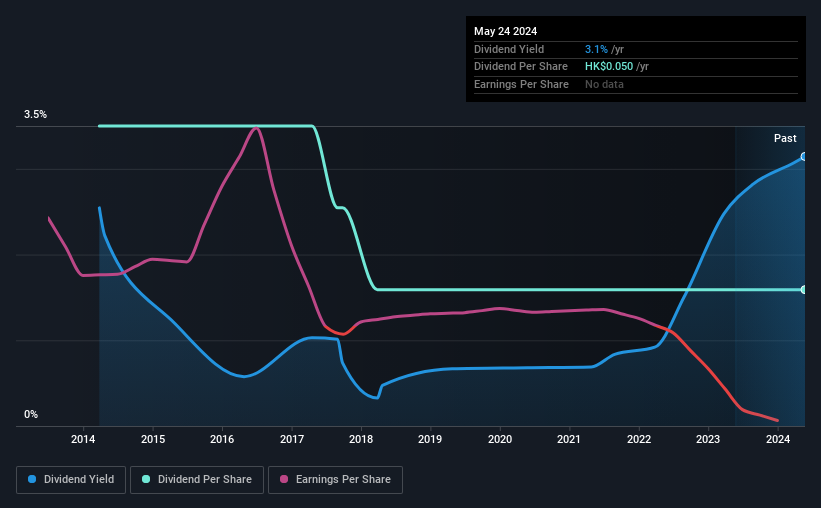
Readers hoping to buy S E A Holdings Limited (HKG:251) for its dividend will need to make their move shortly, as the stock is about to trade ex-dividend. The ex-dividend date is usually set to be one business day before the record date which is the cut-off date on which you must be present on the company's books as a shareholder in order to receive the dividend. The ex-dividend date is of consequence because whenever a stock is bought or sold, the trade takes at least two business day to settle. Thus, you can purchase S E A Holdings' shares before the 29th of May in order to receive the dividend, which the company will pay on the 18th of June.
The company's next dividend payment will be HK$0.03 per share. Last year, in total, the company distributed HK$0.05 to shareholders. Calculating the last year's worth of payments shows that S E A Holdings has a trailing yield of 3.1% on the current share price of HK$1.59. If you buy this business for its dividend, you should have an idea of whether S E A Holdings's dividend is reliable and sustainable. So we need to check whether the dividend payments are covered, and if earnings are growing.
View our latest analysis for S E A Holdings
Dividends are typically paid out of company income, so if a company pays out more than it earned, its dividend is usually at a higher risk of being cut. S E A Holdings paid a dividend last year despite being unprofitable. This might be a one-off event, but it's not a sustainable state of affairs in the long run.
Click here to see how much of its profit S E A Holdings paid out over the last 12 months.

Have Earnings And Dividends Been Growing?
Companies with falling earnings are riskier for dividend shareholders. If business enters a downturn and the dividend is cut, the company could see its value fall precipitously. S E A Holdings reported a loss last year, and the general trend suggests its earnings have also been declining in recent years, making us wonder if the dividend is at risk.
The main way most investors will assess a company's dividend prospects is by checking the historical rate of dividend growth. S E A Holdings's dividend payments per share have declined at 7.6% per year on average over the past 10 years, which is uninspiring. While it's not great that earnings and dividends per share have fallen in recent years, we're encouraged by the fact that management has trimmed the dividend rather than risk over-committing the company in a risky attempt to maintain yields to shareholders.
We update our analysis on S E A Holdings every 24 hours, so you can always get the latest insights on its financial health, here.
The Bottom Line
Is S E A Holdings an attractive dividend stock, or better left on the shelf? S E A Holdings doesn't appear to have a lot going for it, and we're not inclined to take a risk on owning it for the dividend.
Although, if you're still interested in S E A Holdings and want to know more, you'll find it very useful to know what risks this stock faces. Every company has risks, and we've spotted 3 warning signs for S E A Holdings (of which 2 make us uncomfortable!) you should know about.
If you're in the market for strong dividend payers, we recommend checking our selection of top dividend stocks.
Have feedback on this article? Concerned about the content? Get in touch with us directly. Alternatively, email editorial-team (at) simplywallst.com.
This article by Simply Wall St is general in nature. We provide commentary based on historical data and analyst forecasts only using an unbiased methodology and our articles are not intended to be financial advice. It does not constitute a recommendation to buy or sell any stock, and does not take account of your objectives, or your financial situation. We aim to bring you long-term focused analysis driven by fundamental data. Note that our analysis may not factor in the latest price-sensitive company announcements or qualitative material. Simply Wall St has no position in any stocks mentioned.